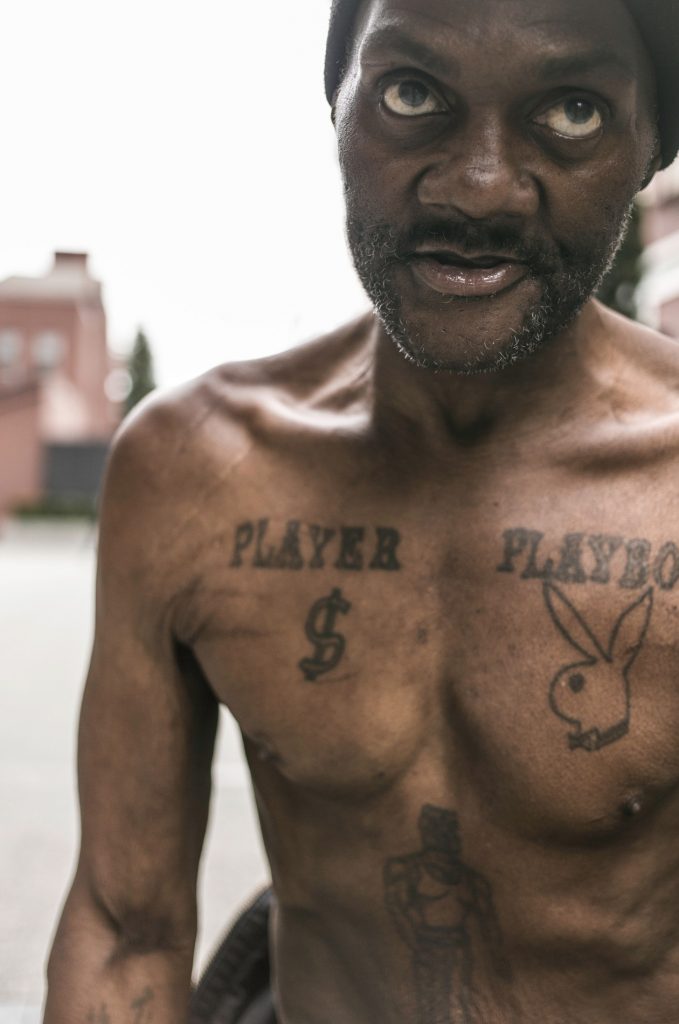The Tenderloin’s reputation goes before it: supposedly the most dangerous area to visit in San Francisco, it’s a central district of about fifty square blocks, nestled beneath the much more gentrified Nob Hill at its northern boundary. Yet amidst the usual (and justified) statistical information about crime, prostitution, drug use and gang activity, the reality – like all cities – is that a district is made up of real people, of real stories that cannot be recorded simply as demographics, or forced into statistical curves.
Two photographers – Brenton Gieser and Felix Uribe – have embarked on an ongoing project Tender Souls to record some of those people living in the Tenderloin. Their subjects range from the disenfranchised through to those working with them, and the intention is to build a living record of a caring community. In their own words: A soul that not only experiences deep suffering but triumphant redemption, a soul that meets the needs of their neighbors with the little gifts they have, a deeply tender soul.
At a time when the rise of dot coms in San Francisco has been well documented in terms of forcing even tenant dwellers out of an increasingly expensive city, the plight of the Tenderloin homeless become even more attenuated and relevant; an acute outlier of a wider trend towards dispossession and marginalization.
The Tender Souls website releases a new story each month of a community member in the tenderloin; a mixture of photographic portraits, and an audio interview. Combined, they provide a riveting insight into the people that are often walked by, relegated to the margins. Some of the anecdotes are profoundly touching (Eva Hart, 72, is ex-army and speaks nine languages; but all her money is spent on trying to reopen her erroneous army records, following expenses incurred by a fight with breast cancer); all of them contain steel and dignity.
In addition to these in-depth accounts, there is also Faces: a larger archive of street portraits; single shots of great sensitivity that project multitudes from the subject. We talked to Brenton Geiser, and asked him about Tender Souls.
How does the collaboration between yourself and Felix work?
First and foremost, Felix and I are great friends. He has not only been one of – if not the – most important person in helping develop my photography, but a person I trust, respect and have an incredible amount of love for.
So our work together is built off a solid foundation of trust. Felix and I are both responsible for finding our own subjects and cultivating those relationships. We constantly chat about the new friends we have made in the neighborhood, and discuss the possibilities of working on their stories. When it comes to documenting stories, we work separately.
For example, I photographed, interviewed, and wrote the stories of Eva and Paul, he did the same for Dax. I have put more of a focus on the stories themselves, as Felix has been capturing amazing portraits around the Tenderloin; although we each contribute to both the stories and faces sections of the site.
I manage the site and write most of the copy, while Felix is a wizard in crafting compelling audio.

With so many potential subjects, how do you choose?
Deciding on who to photograph and document is always a challenge. Of course, working with a subject is a two-way street; people need to be brought into the vision; they need to trust us; they need to be courageous enough to tell us their unadulterated story.
With that being said, I think that most people will be surprised about how many people in the Tenderloin are ‘open books.’ Many times, the suffering and pain our subjects have endured is so immense. For some, telling their story is cathartic; for others. the acknowledgement is what moves them. Most just want to be part of something they believe may be special.
Most of the people we end up working with are people we either meet organically, on the streets while walking around with our cameras; or have been introduced to us by a community member or an organization we have ties to. Both Felix and I really try to be conscious of the rich diversity of the TL, which means we are not aiming just to photograph our un-housed neighbors, or people with substance abuse problems, but also the community leaders, the youth, small business owners. The tapestry of this neighborhood is intricate and nuanced.

How long do you envisage this project lasting?
There is no end date for this project. Felix and I are Bay Area natives, and intend on being part of our regional community for as long as economically possible.
We also have a commitment to the TL community beyond Tender Souls. From the very real friendships we have cultivated with people on the streets, residents, and neighborhood workers, to the neighborhood organizations we now work with, we have plans to be here for quite a while.
How do you see the city evolving, based on what you see at ground level?
I believe the city of San Francisco is creeping up on a pivotal inflection point. At this inflection point, the social fabric of our city is either going to tear and become a microcosm of the social tension we see brewing around the globe; or we can practice compassionate, authentic, human connection across classes; allowing for not only a strong community, but more sound local policy, housing regulations, and business practices moving forward.
We believe photography is an accessible, collaborative art form, which when done right, can facilitate a better understanding of others and ourselves. We hope that Tender Souls provides a spark for a deeper inquiry into social issues that prevail in our back yard, but often go unrecognized.

The Tender Souls Project: http://www.tendersoulsproject.com
